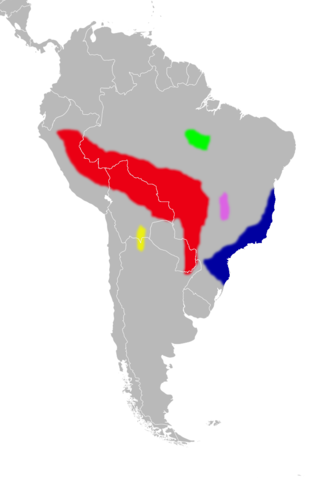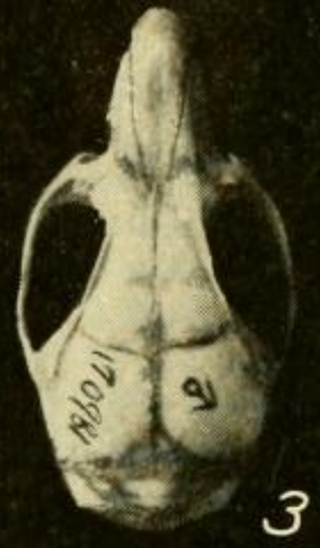
Euryoryzomys emmonsae, also known as Emmons' rice rat or Emmons' oryzomys, is a rodent from the Amazon rainforest of Brazil in the genus Euryoryzomys of the family Cricetidae. Initially misidentified as E. macconnelli or E. nitidus, it was formally described in 1998. A rainforest species, it may be scansorial, climbing but also spending time on the ground. It lives only in a limited area south of the Amazon River in the state of Pará, a distribution that is apparently unique among the muroid rodents of the region.
Hylaeamys laticeps, also known as the Atlantic Forest oryzomys or the large-headed rice rat, is a species of rodent in the family Cricetidae.

Euryoryzomys nitidus, also known as the elegant oryzomys or elegant rice rat, is a rodent species in the family Cricetidae. Previously it was known as Oryzomys nitidus, but it is not closely related to Oryzomys as that genus is now constructed. Its range includes Bolivia, Brazil and Peru to the east of the Andes, in lowland tropical rainforest as well as forest in the eastern foothills of the mountains, at elevations from 50 to 2,000 m.
Hylaeamys perenensis, formerly Oryzomys perenensis, also known as the western Amazonian oryzomys, is an oryzomyine rodent of the family Cricetidae.
Hylaeamys yunganus, also known as the Amazonian oryzomys or Yungas rice rat, is a species of rodent in the genus Hylaeamys of family Cricetidae. It is found in lowland tropical rainforest throughout Amazonia, in northeastern Bolivia, eastern Peru, eastern Ecuador, southeastern Colombia, southern Venezuela, Guyana, Suriname, French Guiana, and northern Brazil. A closely related species, Hylaeamys tatei, occurs only in a small area in eastern Ecuador. Both were previously placed in Oryzomys.
Nephelomys albigularis, also known as the white-throated oryzomys or Tomes's rice rat, is a species of rodent in the genus Nephelomys of family Cricetidae. Described in 1860, it was the first Nephelomys species to be discovered. It was originally described in the defunct genus Hesperomys as Hesperomys albigularis and considered related to the much smaller H. longicaudatus. By 1894, it was placed in Oryzomys, as Oryzomys albigularis, and associated with what is now Nephelomys meridensis. In the early 1960s, the scope of the species was considerably expanded to include most of the species that are now in Nephelomys, as well as a single name, boliviae, that is currently a synonym of Euryoryzomys nitidus. From 1976 on, several of these were reinstated as separate species.
Oreoryzomys balneator, also known as the Peruvian rice rat or Ecuadoran oryzomys, is a species of rodent in the tribe Oryzomyini of family Cricetidae. It is found in Ecuador and northern Peru in cloud forest at elevations from 1500 to 1800 m. It is the only species in the genus Oreoryzomys, which was included in Oryzomys until 2006. The genus name Oreoryzomys is a combination of ορος the Greek word for "mountain" with the old genus name Oryzomys and refers to the mountainous habitat of O. balneator. Recent research suggests that O. balneator is not closely related to Oryzomys, but instead is probably related to Microryzomys within a clade also including Neacomys and Oligoryzomys.

Euryoryzomys lamia, also known as the buffy-sided oryzomys or monster rice rat, is a species of rodent in the family Cricetidae. It is found only in central Brazil, where it lives in forest enclaves within the cerrado. The species' known altitudinal range is from 700 to 900 m. The main threats to its survival are the destruction and fragmentation of its forest habitat.
Euryoryzomys legatus, also known as the Tarija oryzomys or big-headed rice rat, is a species of rodent in the family Cricetidae. It now belongs to the genus Euryoryzomys, having previously been placed in Oryzomys. It is found in the eastern Andes of northwestern Argentina and southern Bolivia.
Hylaeamys megacephalus, also known as Azara's broad-headed oryzomys or the large-headed rice rat, is a species of rodent in the genus Hylaeamys of family Cricetidae, of which it is the type species. It is found mainly in lowland tropical rainforest from its type locality in Paraguay north through central Brazil, French Guiana, Guyana, Suriname, and Venezuela onto Trinidad and Tobago. To its west and east, other closely related species of Hylaeamys are found: H. perenensis in western Amazonia, H. acritus in Bolivia, and H. laticeps and H. oniscus in the Atlantic Forest of eastern Brazil.

Transandinomys talamancae is a rodent in the family Cricetidae that occurs from Costa Rica to southwestern Ecuador and northern Venezuela. Its habitat consists of lowland forests up to 1,500 m (5,000 ft) above sea level. With a body mass of 38 to 74 g, it is a medium-sized rice rat. The fur is soft and is reddish to brownish on the upperparts and white to buff on the underparts. The tail is dark brown above and lighter below and the ears and feet are long. The vibrissae (whiskers) are very long. In the skull, the rostrum is long and the braincase is low. The number of chromosomes varies from 34 to 54.

Aegialomys is a genus of oryzomyine rodents from the lowlands and mountains of western Peru and Ecuador, including the Galápagos Islands. The species in this genus have historically been placed in Oryzomys, but according to cladistic research, the genus is more closely related to a group containing, among others, Nectomys and Sigmodontomys, than to Oryzomys. The generic name Aegialomys means "coastal mouse" in Ancient Greek and references the mostly coastal occurrence of the genus.

Cerradomys is a genus of oryzomyine rodents from eastern Bolivia, Paraguay, and central Brazil found in cerrado, Caatinga and Gran Chaco habitats.

Euryoryzomys macconnelli, also known as MacConnell's rice rat or MacConnell's oryzomys, is a rodent species from South America. It is found in Brazil, Colombia, Ecuador, French Guiana, Guyana, Peru, Suriname and Venezuela, where it lives in lowland tropical rainforest. It was formerly placed in the genus Oryzomys, as Oryzomys macconnelli, but in 2006 it was reclassified as the type species of the new genus Euryoryzomys.
Nephelomys caracolus, also known as the Costa Central oryzomys or caracol rice rat, is a species of rodent in the genus Nephelomys of family Cricetidae. It is found in cloud forest in the Cordillera de la Costa Central of Aragua, Miranda, and the Distrito Federal in north-central Venezuela at elevations from 1000 to 2500 m. It is nocturnal and terrestrial, and has a varied diet. In most Nephelomys species, the posterolateral palatal pits, perforations of the palate near the third molar, are conspicuous and receded into a fossa, but in N. caracolus and the Ecuadorian species N. nimbosus, the pits are much smaller.
Nephelomys meridensis, also known as the Mérida oryzomys, is a species of rodent in the genus Nephelomys of family Cricetidae. It is found in cloud forest in the Sierra Nevada de Mérida of western Venezuela at elevations from 1100 to 4000 m. It is solitary, nocturnal and terrestrial, and has a varied diet.
Hylaeamys acritus, formerly Oryzomys acritus, is an oryzomyine rodent of the family Cricetidae. The name is derived from the Greek word ακριτος 'confused, doubtful', because it could easily be confused with species such as H. megacephalus and Euryoryzomys nitidus. It is known only from northeastern Bolivia; its type locality is within Noel Kempff Mercado National Park. The rodent is terrestrial and is found in moist lowland semideciduous forest and savanna. It has olive brown coloration on its back; the cheeks and flanks are amber, and the top of the head is dark. The coat is 9 mm long at the center of the torso. Chest fur between the front legs is thick and 3 to 4 mm long. Abdominal hairs are gray at the base and white at the top.

Euryoryzomys is a genus of rodents in the tribe Oryzomyini of family Cricetidae. It includes seven species, which are distributed in South America. Until 2006, its members were included in the genus Oryzomys, but they are not closely related to the type species of that genus, and therefore they were placed in a new genus. They are most closely related to genera like Hylaeamys and Transandinomys; many members of these genera were previously placed in a single species, known as Oryzomys capito. The genus name, Euryoryzomys, combines the name "Oryzomys" with the Ancient Greek word eurus "broad", referring to the broad range in distribution of the genus.

Transandinomys is a genus of rodents in the tribe Oryzomyini of family Cricetidae. It includes two species—T. bolivaris and T. talamancae—found in forests from Honduras in Central America south and east to southwestern Ecuador and northwestern Venezuela in northern South America. Until 2006, its members were included in the genus Oryzomys, but phylogenetic analysis showed that they are not closely related to the type species of that genus, and they have therefore been placed in a new genus. They may be most closely related to genera like Hylaeamys and Euryoryzomys, which contain very similar species. Both species of Transandinomys have had eventful taxonomic histories.

Nephelomys is a genus of South American oryzomyine rodents found in the Andes from Bolivia to Venezuela, with a westward extension into the mountains of Costa Rica. Its generic name is derived from the Ancient Greek word nephelê "mist", referring to the cloud forest habitat of the members of the genus.







